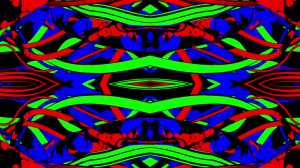
Illuminating was the work of Austrian painter Maria Lassnig at PS1, having just come from Coded After Lovelace at White Box Gallery on the LES. The dominant theme in Lassnig’s work are self-portraits, particularly her representation of ‘body as self’, in which the work -over time- presents her journey from abstract Euclidian form to her haunting painting style. In later work, inner psychological conflicts meet harsh external realities; creature-like heads merge with prosthetic artifices, conveying a low-grade horror, as do armless nudes, echoing the Thalidomide crisis of the 50’s and 60’s, (a drug banned in the U.S. and Europe for causing birth defects). The work intimates a foreboding of advanced technology’s effects on the corporeal (female) experience as ‘self’ threatened or undermined by abstract, pernicious and uncontrollable paternal forces. Coded After Lovelace, a group show displays related aesthetic and ethical concerns expressed in a variety of guises, presented by seven artists who have been both forerunners in the use of art and technology as well as some of its most current and prolific practitioners. The show’s title references Augusta Ada King, Countess of Lovelace an English mathematician and writer chiefly known for her work on Charles Babbage‘s early mechanical general-purpose computer, the Analytical Engin. Amongst this group of artists are significant pioneers whose explorations paved the way for the ubiquity with which media-generated art is currently embraced. Lillian Schwartz’s large projected videos show a variety of work created over a 40+ year time-span; the earliest of which show crude digital geometric animations that merge with bio-cellular structures speaking to a prescient ‘singularity’ writ large. Schwartz, an employee at Bell Labs for 30+ years was given rare access to a state-of-the-art lab to explore and collaborate in the use of digital imagery and sound. One can see the progression of improvement in both the technology as well as Schwartz’s understanding of possibilities and her own facility with it’s applications, particularly in the recent Tacit Expressions, an explosively lush, hypnotic, colorful graphic 3-D experience that speaks to the elegance of technology as a transcendent cosmic art form.
Amongst this group of artists are significant pioneers whose explorations paved the way for the ubiquity with which media-generated art is currently embraced. Lillian Schwartz’s large projected videos show a variety of work created over a 40+ year time-span; the earliest of which show crude digital geometric animations that merge with bio-cellular structures speaking to a prescient ‘singularity’ writ large. Schwartz, an employee at Bell Labs for 30+ years was given rare access to a state-of-the-art lab to explore and collaborate in the use of digital imagery and sound. One can see the progression of improvement in both the technology as well as Schwartz’s understanding of possibilities and her own facility with it’s applications, particularly in the recent Tacit Expressions, an explosively lush, hypnotic, colorful graphic 3-D experience that speaks to the elegance of technology as a transcendent cosmic art form.
 In a related manner Arleen Schloss, known for hosting 80’s performance/techno jams, shows documentation of her ambitious interdisciplinary opera for Ars Electronica Vienna in 1986, A.E. Blah, Blah, Blah. With a large collaborative cast, Schloss humorously plays with language, in her iconic use of the alphabet, and seeks high and low ground in this mixture of performance, video projection, and audio. The documentation of this work generates a kind of joyful dissonance out of abstract components at a time when technology’s fusion with performance was still a relative novelty.
In a related manner Arleen Schloss, known for hosting 80’s performance/techno jams, shows documentation of her ambitious interdisciplinary opera for Ars Electronica Vienna in 1986, A.E. Blah, Blah, Blah. With a large collaborative cast, Schloss humorously plays with language, in her iconic use of the alphabet, and seeks high and low ground in this mixture of performance, video projection, and audio. The documentation of this work generates a kind of joyful dissonance out of abstract components at a time when technology’s fusion with performance was still a relative novelty.


Of a younger generation Carla Gannis’s recent video Non-Facial Recognition Project uses uploaded selfies from the artist’s Facebook newsfeed. In this constantly shifting piece, faces are segmented, stretched, and extruded, morphing seamlessly to reveal hidden biologies as well as collaged masks of variants on bling-y celebrity-style personae. In a related manner, Claudia Hart’s Caress shows a white computer-generated reclining female figure segmented into thirds and echoing classical forms of ancient Greco-Roman and late 19th century statues; the idealized mythic female form now a ghostly robotized image subtly sweeping her arm across a smooth plasticized body. In both of these, animated excesses contrast and compliment the static horror of Lassnig’s paintings; it feels part of a grounded late 20th and early 21st century continuum stretching back to Warhol.
Coursing though these and other works in ‘Coded’ are themes that pose concerns relevant to the philosophical underpinnings of our technologically advanced society; whether such resources are our tools, or are the multitudes, being subtly converted into ‘tools’ at the behest of larger unseen forces, is the world we now negotiate.
